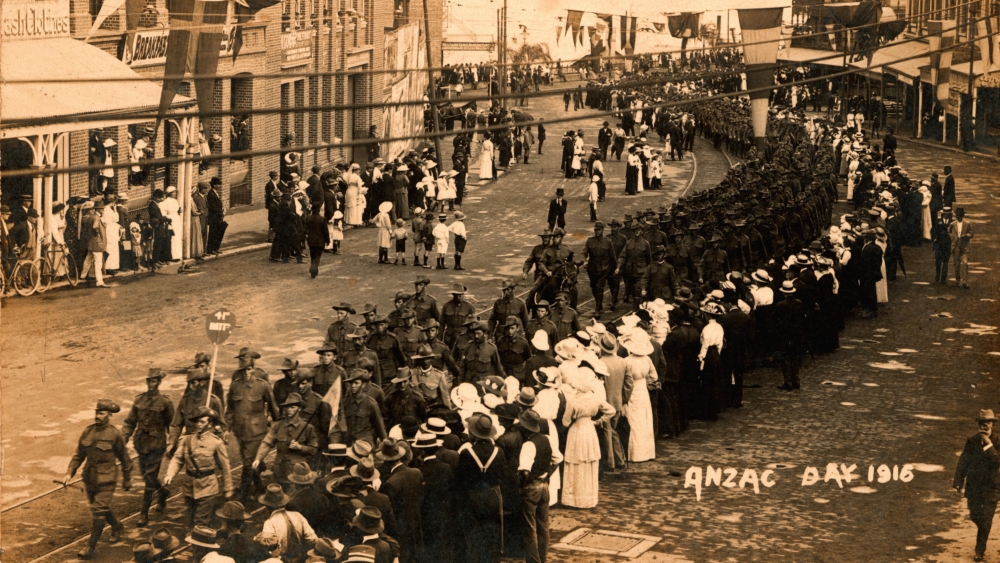The sacred heart of Anzac Day
Historians are rediscovering the role of church leaders in our remembrance ceremonies
When he was director of the Anzac War Memorial in Sydney’s Hyde Park, Darren Mitchell was struck by the similarity of the dawn service on Anzac Day to Anglican liturgy.
“I did find it odd – because I’m an Anglican – that I’m sitting in an Anglican church service except it’s outdoors. It has a lot of the trappings still of that liturgical formation back in the 1910s and ’20s and so I wanted to investigate that,” says Mitchell.
Queensland historian John Moses and New Zealander George Davis had already written about the role of Irish-born Anglican chaplain Canon David Garland in the formation of ceremonies to commemorate the sacrifice of the Anzacs in World War I.
Now Mitchell has uncovered the role of Dean Albert Talbot as part of a PhD looking into the Anglican Church’s influence on the early years of Anzac Day ceremonies, particularly the shape of the liturgy in dawn services.
“Garland was the one up in Queensland and Albert Talbot was very much an initiator, an instigator of the work in Sydney.” – Darren Mitchell
“John Moses’ work on Garland alerted me to the probability that there was someone in each state who took a lead in shaping these services,” Mitchell tells Eternity.
“Clearly Queensland, probably South Australia and NSW were focusing very strongly on making a lot of things happen on that first Anzac Day anniversary in 1916 and Garland was the one up in Queensland and Albert Talbot was very much an initiator, an instigator of the work in Sydney.”
Mitchell does not downplay the key role played by Garland. His committee was the first to be set up and it issued a communique encouraging the appropriate marking of Anzac Day. Even in his own day he was designated the Architect of Anzac Day.
But Mitchell believes that is because Garland left all of the committee’s papers for historians to find, while church leaders in other states who were taking responsibility for commemoration services had conversations that were not available to historians.
“Garland as secretary wrote to mayors of the major towns, possibly the premiers of the states, encouraging them to also mark Anzac Day, but what I found is that at least in NSW and probably in South Australia they were already thinking about it anyway.
“There are equivalents to Garland in other places and one of them is Dean Albert Talbot in Sydney. He was the Dean of St Andrew’s Cathedral from 1912 to 1936, when he died.”
“It’s not surprising that people turned to church leadership to fashion a way in which we could appropriately assuage that grief.” – Darren Mitchell
Talbot was a veteran of the Gallipoli campaign. After Archbishop of Sydney John Wright brought him out from England to serve as Dean, Talbot enlisted as senior chaplain of the Australian Imperial Force and sailed on a troop ship from Albany in Western Australia, serving initially in Egypt and then in Gallipoli.
 “He was on a hospital ship on the day of the landing, he was eventually on shore and he was wounded at Lone Pine in August and as a consequence of that he eventually found himself back in Sydney in March 1916 – and reunited with his wife, who he had just married before departure in 1914. Then he begins to get involved quite rapidly in remembrance work.”
“He was on a hospital ship on the day of the landing, he was eventually on shore and he was wounded at Lone Pine in August and as a consequence of that he eventually found himself back in Sydney in March 1916 – and reunited with his wife, who he had just married before departure in 1914. Then he begins to get involved quite rapidly in remembrance work.”
Mitchell says it is not surprising that senior Anglican clergymen should be key partners in the drive to start Anzac Day ceremonies because at that time more than 50 per cent of Australia’s population would have considered themselves Anglican.
“So in that era in the face of grief and the need for public mourning, it’s not surprising that people turned to church leadership to fashion a way in which we could appropriately assuage that grief; they had the basic knowledge to pay respect to those that paid the ultimate sacrifice,” he says.
“But when you read the history books, it’s been written out of it, so that’s what I think John Moses’ work on Garland and not only myself but a few historians are trying to recapture the involvement of Christian leadership in fashioning what Anzac means rather than just assuming that it was the veterans or government.
“It wasn’t veterans, it wasn’t governments – if anything, it was a partnership not only of those two groups but also of the church leadership, particularly the Anglican church at the time.”
Mitchell says the roles played by Garland and Talbot suggest there is scope for research to be undertaken in other states into what part church leaders played in the development of Anzac.
Mitchell points out that a lot of the elements that have become firmly established as part of our Anzac tradition – periods of one- to two-minutes’ silence, wreath-laying, bugle calls – emerged during wartime.
“There was some national pride around that experience and the fact that we’d already established a focus on that day.” – Darren Mitchell
There were a few events on April 23, 1916, which was Easter Day, but the main Anzac Day ceremonies were initiated on April 25, 1916 – a year to the day after the landing at Gallipoli.
In fact, the first Anzac memorial was actually unveiled in Adelaide on September 7, 1915 – just a couple of weeks after the August Offensive, which was the Allies’ last major attempt to break the stalemate at Gallipoli.
“So there was a very rapid response of respect in Adelaide in this memorial for the Australasians serving in the Dardanelles,” says Mitchell.
He notes that it took a while for Australians to see Anzac Day as a nationwide occasion, with a ripple effect as each state decreed a public holiday in the 1920s.
But the fact that Australia had established its remembrance ceremonies three years before Britain established Armistice Day on November 11, 1919, contributed to our maturing as a nation, Mitchell believes.
“Australians had done their bit in the war and they were given great credit for it.” – Darren Mitchell
“There was some national pride around that experience and the fact that we’d already established a focus on that day,” he says.
“Certainly, there was a feeling that there was a visibility on the international stage, where Australia might be thought of as distinctive from the British empire … as a consequence of the experience at Gallipoli.
“There was reporting in the UK press about how well Australia had done, and I think that was taken to heart back here where that affirmation had value.”
Mitchell says Australia’s standing as a nation on the world stage was confirmed when prime minister Billy Hughes insisted on being part of the peace negotiations towards the Treaty of Versailles discussions, believing it was important that Australia not be represented by the British but have its own voice.
“So at that time obviously we were trying to emerge … and Australians had done their bit in the war and they were given great credit for it, and we should be proud of our remembrance of what occurred.”
Email This Story
Why not send this to a friend?


